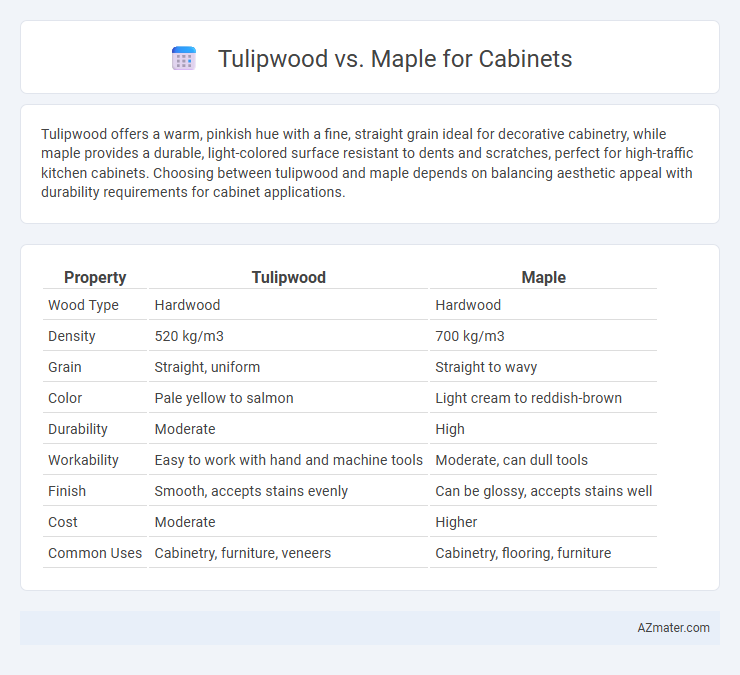Tulipwood offers a warm, pinkish hue with a fine, straight grain ideal for decorative cabinetry, while maple provides a durable, light-colored surface resistant to dents and scratches, perfect for high-traffic kitchen cabinets. Choosing between tulipwood and maple depends on balancing aesthetic appeal with durability requirements for cabinet applications.
Table of Comparison
| Property | Tulipwood | Maple |
|---|---|---|
| Wood Type | Hardwood | Hardwood |
| Density | 520 kg/m3 | 700 kg/m3 |
| Grain | Straight, uniform | Straight to wavy |
| Color | Pale yellow to salmon | Light cream to reddish-brown |
| Durability | Moderate | High |
| Workability | Easy to work with hand and machine tools | Moderate, can dull tools |
| Finish | Smooth, accepts stains evenly | Can be glossy, accepts stains well |
| Cost | Moderate | Higher |
| Common Uses | Cabinetry, furniture, veneers | Cabinetry, flooring, furniture |
Introduction to Tulipwood and Maple for Cabinets
Tulipwood, known for its warm reddish hues and fine grain, offers a unique aesthetic appeal and moderate durability for cabinet construction. Maple, prized for its strength, smooth texture, and light, uniform color, provides excellent resistance to wear and a versatile surface for finishes. Both woods are popular choices in cabinetry, with tulipwood favoring rich visual impact and maple offering superior hardness and longevity.
Key Characteristics of Tulipwood
Tulipwood is prized for its light pink to pale orange hues with subtle brown streaks, offering a warm and distinctive appearance for cabinets. This hardwood features a fine, even grain that provides smooth finishes and excellent paint or stain absorption, making it versatile for various design aesthetics. Tulipwood is moderately dense and durable, ensuring lasting strength while remaining easier to work with compared to harder woods like maple.
Key Characteristics of Maple
Maple is known for its fine, consistent grain and pale, creamy color, making it a popular choice for cabinet construction due to its smooth finish and durability. Its hardness rating on the Janka scale of approximately 1,450 makes it resistant to dents and scratches, ideal for high-traffic kitchen environments. Maple's ability to take stains evenly enhances its versatility, allowing cabinets to be customized in a wide range of tones while maintaining a sleek, modern appearance.
Aesthetic Differences: Tulipwood vs Maple
Tulipwood offers a unique, warm tone with subtle grain patterns, often featuring streaks of reddish or golden hues that create a lively and modern aesthetic for cabinets. Maple presents a more uniform, pale color with fine, consistent grain, lending a clean and classic appearance ideal for versatile design styles. The contrasting textures and colors of tulipwood and maple allow homeowners to choose between a bold, natural look and a smooth, understated elegance in cabinetry.
Durability and Strength Comparison
Tulipwood offers moderate durability with a Janka hardness rating around 950, making it suitable for cabinets that experience light to moderate wear. Maple exhibits greater strength and durability, boasting a Janka hardness of approximately 1450, which resists dents and scratches effectively over time. Choosing maple cabinets ensures longer-lasting performance in high-traffic kitchen environments compared to tulipwood.
Workability and Ease of Finishing
Tulipwood offers excellent workability due to its moderate density and straight grain, allowing for smooth cutting, shaping, and sanding. Maple, known for its hardness and fine, uniform texture, can be more challenging to work with but yields a durable, smooth surface ideal for detailed cabinetry. Both woods take finishes well; however, tulipwood's open grain absorbs stains unevenly, requiring pre-sealing, while maple's dense grain allows for a more consistent finish and glossy appearance.
Cost Differences Between Tulipwood and Maple
Tulipwood typically costs less than maple, making it a budget-friendly choice for cabinets without compromising durability. Maple, known for its hardness and smooth grain, carries a higher price due to its superior strength and premium appearance. Homeowners often weigh the cost differences between tulipwood and maple, considering tulipwood for affordable cabinetry and maple for long-lasting, high-end finishes.
Sustainability and Environmental Impact
Tulipwood, harvested primarily from fast-growing trees like eastern tulip poplar, offers a renewable option with a lower environmental footprint compared to slower-growing hardwoods like maple. Maple cabinets, while highly durable and long-lasting, often come from trees with longer maturation periods, leading to concerns about deforestation and resource depletion. Choosing tulipwood for cabinetry supports sustainable forestry practices due to its rapid regrowth and efficient carbon sequestration, making it an eco-friendlier choice for environmentally conscious homeowners.
Best Applications for Each Wood Type
Tulipwood excels in applications requiring a lighter color and smoother grain, making it ideal for contemporary kitchen cabinets and decorative paneling where a modern aesthetic is desired. Maple offers exceptional durability and a tight grain pattern, making it the best choice for high-traffic areas like cabinetry in kitchens and bathrooms that demand resilience and resistance to wear. Both woods perform well in cabinetry but selecting Tulipwood suits projects prioritizing visual appeal, while Maple is preferred for longevity and strength.
Conclusion: Choosing Between Tulipwood and Maple for Cabinets
Tulipwood offers a distinctive grain and warm reddish tones ideal for unique, eye-catching cabinets, while maple provides a smooth, consistent texture with superior durability and resistance to dents. For cabinets requiring elegant aesthetics and moderate use, tulipwood is a suitable choice, whereas maple excels in high-traffic kitchen environments due to its robust hardness rating on the Janka scale. Selecting between tulipwood and maple ultimately depends on prioritizing either visual appeal or long-term resilience in cabinetry applications.

Infographic: Tulipwood vs Maple for Cabinet
 azmater.com
azmater.com